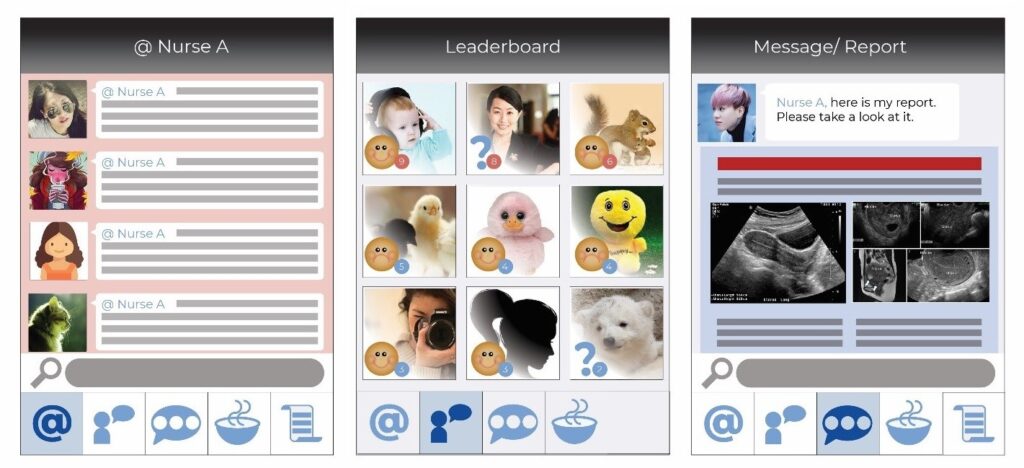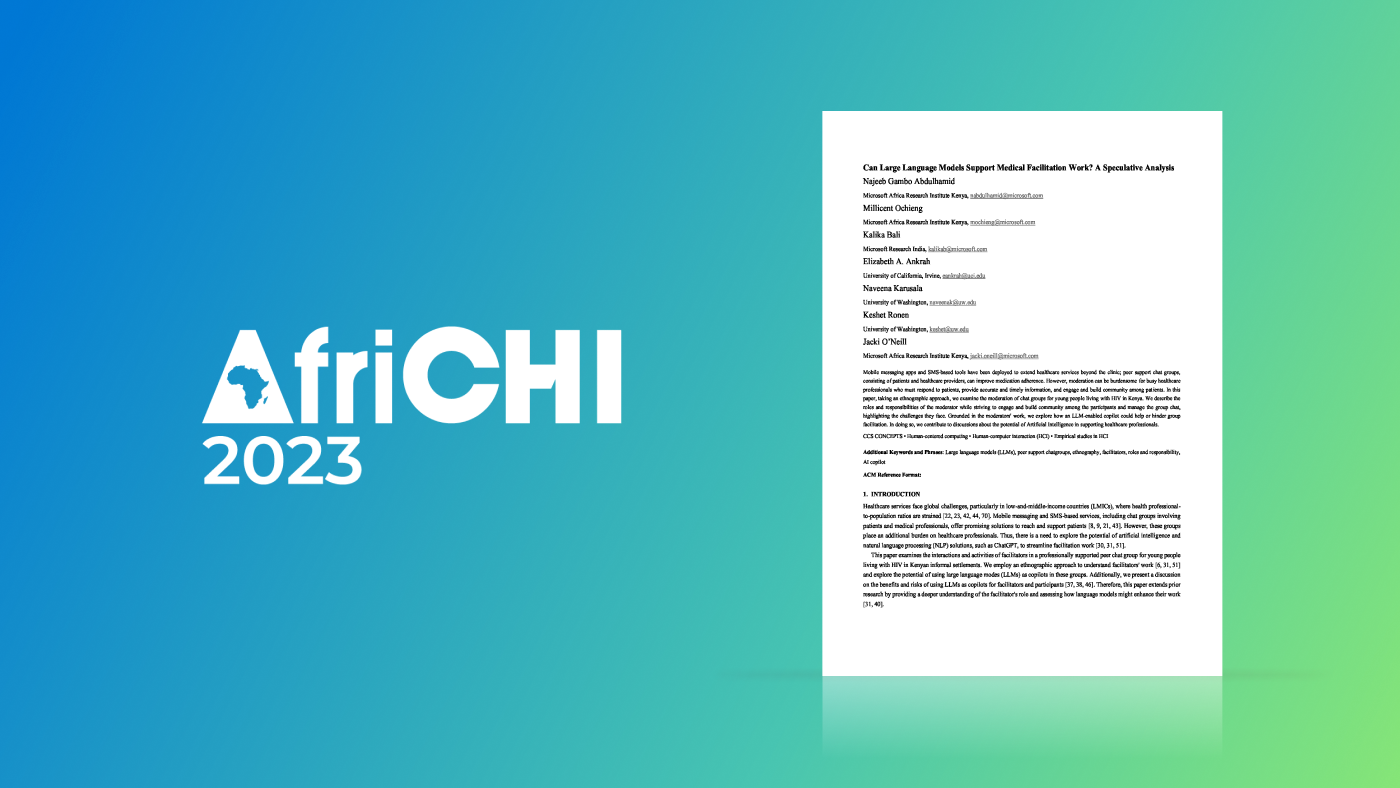
According to a report released by World Bank and the World Health Organization in 2017 (opens in new tab), there are nearly 4 billion people worldwide, that’s half of the world population, who lack access to essential healthcare. Although delivering high-quality patient-centered care is at the heart of good healthcare, this is no easy task due to both cost and scalability.
Having good communication between providers and patients is vital to quality of care and ideal healthcare outcomes. However, it can be costly and challenging to facilitate, especially in cost-conscious Global South settings, where the ratio of medical professionals to patients is often extremely low and the availability of in-person consultations is scarce. The Global South is a region of the world that includes countries in Asia, Africa, Latin America, and the Caribbean that may have less access to resources due to a number of factors.
Microsoft research podcast
Meanwhile, chat apps are widely used in healthcare today. They have many applications: internal communication, public engagement, and patient outreach beyond working hours or the physical bounds of hospital operations. We believe that chat offers a novel opportunity to enhance the access, engagement, and quality of care. However, we also recognize the burden that chat puts on doctors and nurses who will need to attend to patients both in person and through chat apps, during hospital working hours and often outside of these hours. Therefore, our research aimed to answer the question: How do we address the tension between the access to high-quality patient-centered care for more people and the necessary work to deliver such care for already stressed healthcare systems?
Our team of researchers conducted ethnographic research at an in vitro fertilization (IVF) clinic in China. Our research included observation of the nurses’ work, interviews with the nurses and doctors, and an examination of the chat messages that best illustrate the work the nurses carry out on WeChat. Our findings are detailed in a paper accepted at the ACM CHI Conference on Human Factors in Computing Systems (CHI 2020) (opens in new tab), called “Please call the specialism: Using WeChat to support patient care in China.” (opens in new tab) The paper also won an Honourable Mention Award. (opens in new tab)

From our fieldwork we found that the IVF clinic attracts a huge number of patients from across the country since it’s a top clinic in China. The result of such a high patient volume is that each patient has less than five minutes in their consultation. Given that its location is culturally and ethnically diverse in addition to being economically less developed, a number of patients who come to the clinic are of limited literacy and may speak various dialects. Additionally, IVF treatment is also an incredibly complicated process. All these factors pose a huge communication challenge to the clinic and have a great impact on patients’ medical adherence and treatment outcomes.
Integrating WeChat into daily nursing routines: Ingenious solutions alongside challenges
In one treatment group from our study, two nurses handle an average of 170 patients daily, which does not include the patients who come in for ad hoc visits. The two nurses were often overwhelmed by the amount of communication happening simultaneously—while they were talking to one patient in person, they were interrupted by phone calls from the desk phone, their work mobile phones, and their personal mobile phones, all pinging with incoming messages. To address the communication challenge, the clinic turned to WeChat.
In order to make up for limited in-person communication, nurse-facilitated patient WeChat groups were created. There are obvious advantages that come out of creating such groups. For example, patients can now receive care from anywhere at any time. However, challenges arise too—volume of messages is one of these. The nurses receive an overwhelming amount of messages (approximately 10,000 messages per day) and often only have time to deal with these messages on their own time, during lunch breaks and after or before work.
It is simply an impossible mission to read thousands of messages! The nurses needed to develop tactics to deal with this vast number of messages. When new patients were enrolled, with their consent they were added to existing patient groups instead of creating new groups each time. This is a deliberate choice by the nurses, who have learned that the patients who have been in the groups longer, and are therefore further along in their treatment, are a useful resource for the newer patients to get additional information and peer support.
During the orientation, nurses also explicitly instructed patients to use an “@” symbol if they needed to get a direct answer from the nurse, otherwise the message would be understood as a question to the group in general. When the nurses began their workday, they first looked for messages on WeChat that were directed at them using the “@” symbol. Unlike Slack or Twitter, which separate out all the “@” messages for a user, WeChat does not have the function to separate these messages. In WeChat, nurses are currently required to manually sift through the roughly 10,000 messages a day, looking for “@” signs. The “@” symbol stands out especially well because it is starkly different from the Chinese character set, making the symbol easy for nurses to find it quickly among large volumes of messages.
After responding to all “@” messages, the nurses skim through the interactions between patients, looking for the most active patients. According to the nurses, if a patient was particularly active one day and kept on posting one issue over and over again, it was a good indicator that this patient must be unhappy (either with the current treatment outcome or the clinic) and in distress. This required early intervention by the nurses. For cases requiring early intervention, nurses often followed up with the patients individually in person or via a phone call. They would bring this up during the morning meeting with the doctor so that the doctor could also pay extra attention to the patient when they came in.
When it comes to privacy, nurses in the clinic are very aware of the patients’ privacy concerns of using a chat app to share information, realizing that patients in the IVF clinic are generally more cautious and sensitive. When they use the chat app, they are careful to use professional judgment and practices to determine whether a message should be sent via chat groups, one-on-one chat, or moving a conversation offline (see more about contextualizing privacy in the discussion section of our paper). Our work is a first step in exploring chat use in the healthcare setting, and more work is needed to address data privacy concerns if chat groups are to become an established part of healthcare. It’s highly important that the use of chat apps in a healthcare setting adhere to both healthcare industry and government regulatory and compliance requirements based on local context.
Future design considerations to empower the healthcare community
Though WeChat is well incorporated in this clinic, there are still issues with using it. For instance, it is easy to miss messages given the volume of messages that come in each day and the lack of a separate tab for “@” messages. Therefore, we propose a series of design suggestions to improve the functionalities of chat (both UI- and AI-based suggestions), which aims at reducing the burden the nurse facilitators bear—from adding an “@” message tab to adding sentiment analysis to the messages, and from providing an at-a-glance view of the patient’s dietary report to separating the medicine-exchanging messages.
Below are a few features that could be helpful for nurses, doctors, and patients in the future based on our research (see Figure 1 for visual prototypes). These require further research and implementation into chat apps to assess effectiveness:
- “@” message tab and pre-edited messages: A separate “@” message tab would allow caregivers to have easy access to messages directed at them from patients. Integrating name detection, like some social media’s mention feature, would allow patients to easily tag a nurse or doctor. Pre-edited messages (like “Please come in for an appointment at…”) would save caregivers’ time.
- Leaderboard tab: a feature that ranks the most active members on a daily basis could assist caregivers in identifying which patients need immediate care. This feature could also look for repeated topics and help to address recurring concerns. The tab could also potentially benefit from sentiment analysis, which could help nurses get a better snapshot of a day’s activities.
- Separate report and input/output report tabs: These features would allow a space for the specific act of filling out and reading reports, which makes up a bulk of nurses’ work. The latter could incorporate special inputs/outputs for report forms (such as tables) that would allow patients to fill out forms more easily and increase accessibility to analysis on the nurses’ end.

Figure 1: From left to right, a prototype mock-up of what the “@” message screen, leaderboard screen, and message/report screen could look like.
Creating a strong network of support with chat groups
There is great value in the messages shared in the groups. It is well known that people don’t take in much information during patient-doctor consultation at the IVF clinic. After all, how much information could a patient in distress who only has five minutes with the doctor take in? Questions submitted on medication help patients get real-time clarification and reassurance from nurses. The possibility of sending in ultrasound and blood test reports allows for remote patients to receive treatment from a top clinic, which would otherwise be impossible. Since these reports are for the nurses’ use, the nurses explicitly tell patients not to comment on or share these reports.
Lastly, the nurses keep an eye on patients’ self-tracking reports daily to ensure the adherence from patients. The reports act as data points for the nurses to evaluate their progress, though they only reply to one or two per day. These replies work both as a nudge for the patient that they need to adhere to medicine and, in some cases, a lifestyle change (like adding more protein in their diet). The reports also help nurses to closely track any early indication of complications.
At the same time, the chat groups are incredibly valuable given their peer support element. IVF treatment can be tough, and there is not always a guaranteed ideal outcome. Being able to receive the emotional support from people who are going through the same journey, or those who have made it through to the end, keeps the patients motivated and optimistic. In addition to the emotional support value, there’s a lot of practical information being shared in the group, such as where to find good accommodations near the hospital or trading and exchanging medicines between patients to save costs. These WeChat groups are an inseparable part of the treatment in this clinic.
Chat as an integral component in healthcare
Chat is a promising way to enhance access, engagement, and quality of healthcare. It is valuable for both nurses and patients in that it enables nurses to extend care beyond limited consultations, empowers patients to get advice anywhere, and provides an important emotional and practical addition to care through peer support. However, such outreach comes at a cost to the healthcare provider, which impacts scalability. Therefore, the core opportunity for future work is in exploring how AI and Microsoft analytics tools can be applied to reduce the burden on providers and make facilitation easier.
If you are interested in more information about how chat apps can potentially benefit healthcare workers and patients, there are a number of additional resources to check out. In another CHI paper, called “Making Chat at Home in the Hospital: Exploring Chat Use by Nurses,” (opens in new tab) our research looks at how WhatsApp is being used by nurses in India. You can also check out our interactive prototype (opens in new tab), which includes design recommendations from our paper. Following up on work introduced in this blog post, we are in the process of beginning a new project, which aims at extending patient outreach via chat app technologies. The goal will be to partner with health organizations that run peer groups to design and build natural language processing-based interventions to help reduce human facilitators’ workload.





